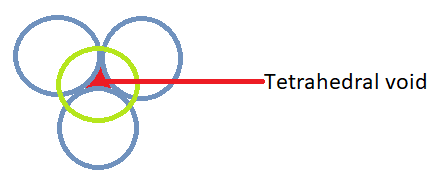Answer
399.9k+ views
Hint: Disodium oxide has an anti-fluorite structure. The cations take up the void here. If we can find the type of void in the anti-fluorite structure, we can find the number of atoms which surround the sodium cation.
Complete answer:
We know that coordination number is the number of ions or atoms the central metal ion holds. In the given question, we have to find out the coordination number of sodium cation in disodium oxide.
Here, we have to know that disodium oxide forms an anti-fluorite structure. In an anti-fluorite structure, the position of the cations and anions is exchanged from their original positions in the fluorite structure.
In fluorite structure, the cations are in the fcc lattice and the anion take up the tetrahedral voids whereas in anti-fluorite structure, the cations lie in the tetrahedral voids and the anions will be packed in the fcc.
In disodium oxide, we have $N{{a}^{+}}\text{ and }{{\text{O}}^{2-}}$. As it has an anti-fluorite structure, the superoxide anion will lie in fcc and the sodium cation will take up the tetrahedral voids.
We know that a tetrahedral void is formed when one more atom is placed on top of the triangular void i.e. the ion which will lie in this tetrahedral void will have 4 surrounding atoms or ions.

As the sodium cation will lie in the tetrahedral voids, surrounded by 4 oxygen atoms so its coordination number will be 4.
Therefore, the correct answer is the coordination number of $N{{a}^{+}}$ in $N{{a}_{2}}O$ is 4.
Note: The alkali metals oxides with the structure ${{M}_{2}}O$ crystallize in fluorite or anti-fluorite structure. The Bravais lattice of fluorite or anti-fluorite structure is fcc i.e. face centered cubic. In such lattice, the lattice points are at every corner of the cube and also on each face centre.
Complete answer:
We know that coordination number is the number of ions or atoms the central metal ion holds. In the given question, we have to find out the coordination number of sodium cation in disodium oxide.
Here, we have to know that disodium oxide forms an anti-fluorite structure. In an anti-fluorite structure, the position of the cations and anions is exchanged from their original positions in the fluorite structure.
In fluorite structure, the cations are in the fcc lattice and the anion take up the tetrahedral voids whereas in anti-fluorite structure, the cations lie in the tetrahedral voids and the anions will be packed in the fcc.
In disodium oxide, we have $N{{a}^{+}}\text{ and }{{\text{O}}^{2-}}$. As it has an anti-fluorite structure, the superoxide anion will lie in fcc and the sodium cation will take up the tetrahedral voids.
We know that a tetrahedral void is formed when one more atom is placed on top of the triangular void i.e. the ion which will lie in this tetrahedral void will have 4 surrounding atoms or ions.

As the sodium cation will lie in the tetrahedral voids, surrounded by 4 oxygen atoms so its coordination number will be 4.
Therefore, the correct answer is the coordination number of $N{{a}^{+}}$ in $N{{a}_{2}}O$ is 4.
Note: The alkali metals oxides with the structure ${{M}_{2}}O$ crystallize in fluorite or anti-fluorite structure. The Bravais lattice of fluorite or anti-fluorite structure is fcc i.e. face centered cubic. In such lattice, the lattice points are at every corner of the cube and also on each face centre.
Recently Updated Pages
Basicity of sulphurous acid and sulphuric acid are

Three beakers labelled as A B and C each containing 25 mL of water were taken A small amount of NaOH anhydrous CuSO4 and NaCl were added to the beakers A B and C respectively It was observed that there was an increase in the temperature of the solutions contained in beakers A and B whereas in case of beaker C the temperature of the solution falls Which one of the following statements isarecorrect i In beakers A and B exothermic process has occurred ii In beakers A and B endothermic process has occurred iii In beaker C exothermic process has occurred iv In beaker C endothermic process has occurred

What is the stopping potential when the metal with class 12 physics JEE_Main

The momentum of a photon is 2 times 10 16gm cmsec Its class 12 physics JEE_Main

How do you arrange NH4 + BF3 H2O C2H2 in increasing class 11 chemistry CBSE

Is H mCT and q mCT the same thing If so which is more class 11 chemistry CBSE

Trending doubts
Fill the blanks with the suitable prepositions 1 The class 9 english CBSE

Difference between Prokaryotic cell and Eukaryotic class 11 biology CBSE

Difference Between Plant Cell and Animal Cell

Fill the blanks with proper collective nouns 1 A of class 10 english CBSE

What is the color of ferrous sulphate crystals? How does this color change after heating? Name the products formed on strongly heating ferrous sulphate crystals. What type of chemical reaction occurs in this type of change.

One Metric ton is equal to kg A 10000 B 1000 C 100 class 11 physics CBSE

Change the following sentences into negative and interrogative class 10 english CBSE

Net gain of ATP in glycolysis a 6 b 2 c 4 d 8 class 11 biology CBSE

What organs are located on the left side of your body class 11 biology CBSE



